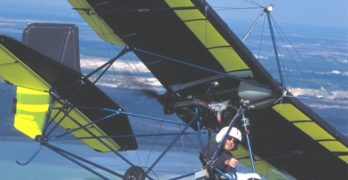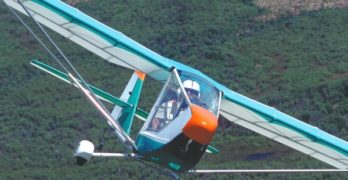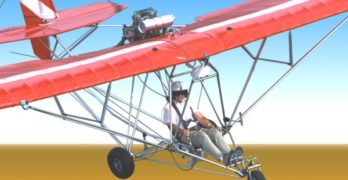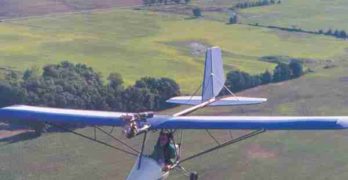Excelling at “Just For Fun”
Going back to our roots and the dandy little ultralights that have given in-flight satisfaction to so many, we’re going to take a look at one of those aircraft, Quicksilver’s MX Sprint.
Some veteran pilots call the MX Sprint “humble,” but it is one of those “original” ultralight aircraft that simply won’t go away, and it shouldn’t. Why? Because the Sprint still offers a joyful flying experience that redefines boring holes in the sky. You pilot a Sprint in relative ease and at remarkable low cost, and once price enters the discussion, many ultralights show their value clearly.
Many in light-sport aviation are realizing that aircraft certified Experimental Light-Sport Aircraft (ELSA) and Special Light-Sport Aircraft (SLSAs), even when approved under a simplified, industry-created, ASTM-guided program, will be rather expensive aircraft. Some sleek fiberglass creations are reaching toward the six-figure mark – an unbelievable development given that ultralights have historically traded in a range of $8,000 to $35,000, the latter being a superbly equipped, Rotax 912-powered machine.
Search Results for : Part 103
Not finding exactly what you expected? Try our advanced search option.
Select a manufacturer to go straight to all our content about that manufacturer.
Select an aircraft model to go straight to all our content about that model.
It’s a Winner; CGS Hawk Sport
Given Chuck Slusarczyk’s decades in recreational aviation, I imagine almost everyone in ultralight aviation has heard of the funny, Polish-speaking pioneer with the hard-to-pronounce last name (Slew-Sar-Chick). If Chuck had named his first business Slusarczyk Glider Supplies, pilots would have stumbled and renamed it for him. Knowing his name is a tongue twister, he wisely called it Chuck’s Glider Supplies.
In his early business years, when Chuck was younger and slimmer, he made hang gliders. Lots and lots of hang gliders. I flew one, as did thousands of others. He was one of a handful of east-of-the-Mississippi hang glider manufacturers. Being a long way from the West Coast where hang gliding was centered back in the ’70s, Chuck made the Californians nervous. They couldn’t keep an eye on his developments and he was regarded as unpredictable. Those who knew him thought the word should be innovative.
Then came powered hang gliding, such as it was in those days.
More Fun for Two People
More Fun for Two People
What could be more fun for two people than an Air Création Fun 450 trike? Okay, I don’t really want to know the answer you were about to give. Next to that, those Frenchmen in Aubenau certainly know what they’re doing. In the state of design and execution, Air Création arguably makes the finest trikes in the world.
The Fun Racer was an early trendsetter, before everyone wanted to buy a 2-seater. The “Racer” part of the name came from the carriage and it acquired this name due to a lower-slung, racier look. The “Fun” part refers to the wing. This wing design is Air Création’s entry as a single-surface model. It has worked so well for them that it has remained in their line almost since the beginning.
To jazz up the Racer trike, a few years back they paired it with the XP-11 or XP-12 wings.
Breese With HKS Engine Is A Winner
Twenty-something years of ultralight flying have seen many changes take place in our ultralights. At the beginning of the ultralight industry we had craft such as Eagles, Weedhoppers, and Quicksilvers powered by engines like the 15-hp Yamaha, Mac 101, and Chrysler. Of these, only Quicksilver remains vibrant.
Here in 2004, we have aircraft like the Breese DS with its 60-hp HKS 700E 4-stroke engine. It may look like a Quicksilver but it’s a different flying animal. M-Squared’s Jay Stevens gave me a checkout in the single-seat Breese with its Japanese 4-stroke powerplant and it proved to be a very satisfying experience.
Strong and Powerful
The resemblance to Quicksilver, especially the California company’s strut-braced model, is obvious to most ultralight veterans but Breese manufacturer M-Squared has steadily changed their design. Looks, therefore, can be deceiving.
The use of struts first set apart the designs of Paul Mather, proprietor of M-Squared. A tailplane that uses no cable bracing added to the different appearance.
Seagull Aerosports takes a new angle
Seagull Aerosports takes a new angle on weight-shift construction with a fully enclosed cockpit.
Developer Michael Riggs might prefer I called his Escape Pod something other than Everyman’s Motorglider, but if you have any interest in self-launched soaring flight, Riggs’ invention is one of the most cost-efficient purchases you can make. The Escape Pod costs thousands less than ultralight motorgliders and literally hundreds of thousands less than sailplane motorgliders.
Oh, and one more thing this kind of flying machine is a hoot to fly. That the Escape Pod also transports easily, can be stored in a small space and is attractively shaped are icing on the cake.
Sure, it’s obvious-I like the Escape Pod. But could it be for you, too? Even if this aircraft isn’t your type, you might enjoy reading about how thoughtfully it was designed.
Trike Motorgliders
Before the Sport Pilot/Light-Sport Aircraft (LSA) rule was recently passed, trike enthusiasts had several other ways to fly such aircraft.
Flightstar Classic
A great old name has returned! The Flightstar is back. Actually, the design has survived various ownership changes quite well. The original Pioneer Flightstar became the Argentine Aviastar. Now original designer, Tom Peghiny, has bought the plane and the name.
It’s all-American again, too, made in the USA. Above you see the F.A.R. Part 103-legal version, the Flightstar Classic. The Classic has a big brother single seater and of course, a two-seat trainer. The Classic is the company’s primary fun machine, though.
All the Flightstars were designed under accepted engineering methods. They’ve also been given the touch by Peghiny, an ultralight pioneer who aviation business experience dates back to his teens. It’s easy to see this successful combination if you examine individual component design and finish.
The Flightstar has an avid following of five hundred owners who love the way their planes fly. The Classic has simple features and low price while maintaining wonderful handling qualities.
Connie Amphib — “The Flying Float” (and it is!)
Check out Bobbie Bailey’s Connie Amphib.
Many pilots are aware of aircraft referred to as flying boats. Among ultralight aircraft, the Aventura, SeaRey and Buccaneer stand out as good examples as do trikes like Polaris’ Flying Inflatable Boat. The flying boat reference describes those aircraft built around a boat hull with substantially different structure than airplanes equipped with two floats.
That clear definition is blurred by the introduction of a novel new ultralight from the inventive mind of Bobbie Bailey. His new Connie amphibian is neither flying boat nor a float-equipped ultralight. My BRS associate, Gregg Ellsworth, tagged it a “flying float.” Works for me.
Canada’s Lotus Float company offers a single float setup that functions much the same way but is an add-on to a wheeled ultralight. This may make a perfectly fine floatplane, but you have to do the fitting yourself, and it simply won’t be as elegant as Bailey’s Connie amphib.
Four-Stroke Engines for Ultralights
Ultralights have long been defined by their two-stroke engines. Rotax and other brands refined the two-stroke for aircraft use, and today’s two-stroke powerplants deserve their popularity. In the important power-to-weight ratio, two-strokes are hard to beat. Their cost is low, their overhauls cheap; these humble powerplants have lifted many a pilot into the air for many hours.
But despite the improvements, despite plentiful businesses to help you maintain your two-stroke engine, and despite a good performance record, two-strokes are still seen as inferior to four-strokes by many aviators.
Add to these impressions the regulatory changes many see as inevitable. The blue-smoking two-stroke (even when optimized) presents environmental problems for snowmobiles, watercraft and gas-powered lawn tools. Two-stroke days are numbered—not because of efficiencies, but because of ecological concerns and political decisions.
Hail the Four-Stroke
General aviation people say, “Well, of course four stroke is better.” But that’s the only kind of engine most of them know, and their aircraft weigh enough to accommodate heavier powerplants.
Transitioning?
A primer for ultralight pilots transitioning themselves and their machines
Ultralight pilots flying legal Part 103 single-place ultralights are not affected by the sport pilot/light-sport aircraft rule. The rules of FAR Part 103 remain the same. Current and future ultralight pilots are free to enjoy those freedoms. If they choose to become sport pilots at a later date, any training logged as a registered ultralight pilot can be counted toward the training requirements for a sport pilot certificate. The rule pertaining to legal ultralight vehicles also do not change.
The sport pilot and lightsport aircraft (SP/LSA) rule is now officially part of the American aviation culture. Some of us who fly Part 103-legal ultralights will continue to be ultralight pilots. Others who fly two-place or overweight machines must eventually transition themselves to sport pilot status and their machines to light-sport aircraft status to remain legal.
With the rule now final, we’ll address the requirements for those ultralight pilots and instructors wishing to transition themselves and their machines.
Product Lines – July 2004
St. Paul, Minn. – Paraphrasing a famous speaker, “You can satisfy all of the people
some of the time or all of the people some of the time, but, well| that’s about it.
I’m referring
to my story about Raven Sky Sports – it’s sale, then non-sale, and the challenge
to its name. First, I got in trouble for announcing
a purchase by an Oregon-based pilot. He and founder/owner Brad Kushner could
never quite close an almost-done deal. The would-be buyer was at first very upset
with me that I would share this news with the public without getting permission (though
I received an email announcement letter along with numerous other recipients). We
patched that up between us but then the sale never happened.
Next, I got a very unhappy but carefully written, four-page letter from the lawyer
who asked Kushner to stop using the name Raven Sky Sports. He thought I characterized
him in a poor light.
- « Previous Page
- 1
- …
- 33
- 34
- 35
- 36
- 37
- …
- 53
- Next Page »









